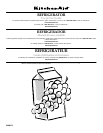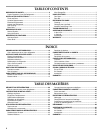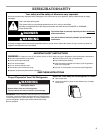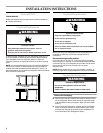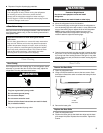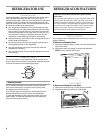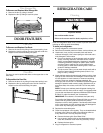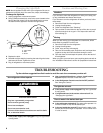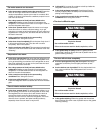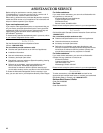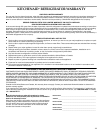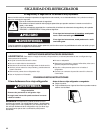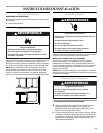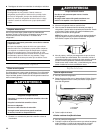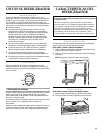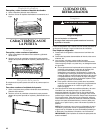
9
The motor seems to run too much
■ Is the temperature outside hotter than normal? Expect the
motor to run longer under warm conditions. At normal
outdoor temperatures, expect your motor to run about 40%
to 80% of the time. Under warmer conditions, expect it to run
even more of the time.
■ Has a large amount of food just been added to the
refrigerator? Adding a large amount of food warms the
refrigerator. It is normal for the motor to run longer in order to
cool the refrigerator back down.
■ Is the door opened often? Expect the motor to run longer
when this occurs. In order to conserve energy, try to get
everything you need out of the refrigerator at once, keep food
organized so it is easy to find, and close the door as soon as
the food is removed.
■ Is the control set correctly for the surrounding
conditions? See “Using the Control.”
■ Is the door closed completely? Push the door firmly shut. If
it will not shut all the way, see “The door will not close
completely” later in this section.
■ Are the condenser coils dirty? This prevents air transfer and
makes the motor work harder. Clean the condenser coils. See
“Cleaning.”
Temperature is too warm
■ Is the door opened often? Be aware that the refrigerator will
warm when this occurs. In order to keep the refrigerator cool,
try to get everything you need out of the refrigerator at once,
keep food organized so it is easy to find, and close the door
as soon as the food is removed.
■ Has a large amount of food just been added to the
refrigerator? Adding a large amount of food warms the
refrigerator. It can take several hours for the refrigerator to
return to the normal temperature.
■ Is the control set correctly for the surrounding
conditions? See “Using the Control.”
■ Is the base grille blocked? For best performance, do not
install the refrigerator behind a cabinet door or block the base
grille.
There is interior moisture buildup
■ Is the door opened often? To avoid humidity buildup, try to
get everything you need out of the refrigerator at once, keep
food organized so it is easy to find, and close the door as
soon as the food is removed. When the door is opened,
humidity from the room air enters the refrigerator. The more
often the door is opened, the faster humidity builds up,
especially when the room itself is very humid.
■ Is it humid? It is normal for moisture to build up inside the
refrigerator when the air is humid.
■ Is the food packaged correctly? Check that all food is
securely wrapped. Wipe off damp food containers before
placing in the refrigerator.
■ Is the control set correctly for the surrounding
conditions? See “Using the Control.”
The door is difficult to open
■ Is the gasket dirty or sticky? Clean the gasket and the
surface that it touches. Rub a thin coat of paraffin wax on the
gasket following cleaning.
The door will not close completely
■ Are food packages blocking the door open? Rearrange
containers so that they fit more tightly and take up less
space.
■ Are the shelves out of position? Put the shelves back into
their correct positions. See “Refrigerator Use” for more
information.
■ Is the gasket sticking? Clean the gasket and the surface
that it touches. Rub a thin coat of paraffin wax on the gasket
following cleaning.
WARNING
Explosion Hazard
Use nonflammable cleaner.
Failure to do so can result in death, explosion, or fire.
WARNING
Explosion Hazard
Use nonflammable cleaner.
Failure to do so can result in death, explosion, or fire.



